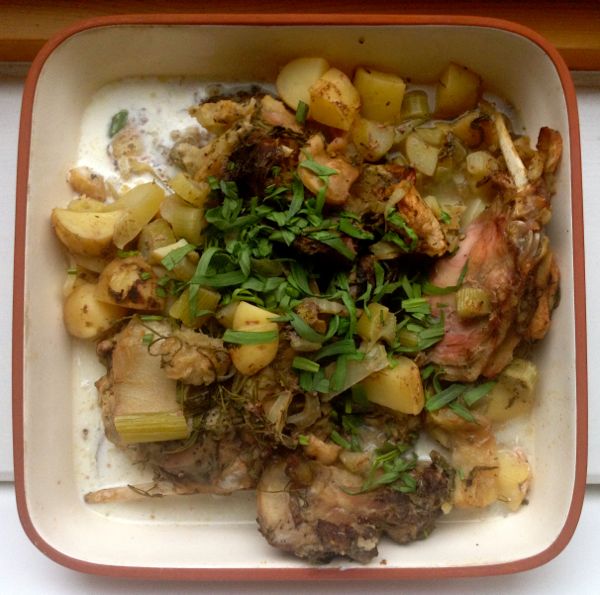Slow Cooker Fodmap Friendly Garlic Oil
Today is a great day for me. It’s the day I get to combine my two food obsessions and talk about slow cookers and FODMAPs. Basically this is a birthday present to myself. North/South Food is five years old this week and I haven’t had time to make a cake to celebrate, so writing a piece about my two favourite subjects will do instead!
I’ve given a little bit of background on Fodmaps before on this post, but if you don’t have time to read back, I’ll give you a crash course here too (bearing in mind my level of scientific knowledge wouldn’t even make it onto a L’Oreal advert voiceover.) They are a relatively recent discovery and research and knowledge into them is ever evolving so don’t take my word as gospel rather than an overview.
FODMAPs as an acronym stands for Fermentable Oligo-saccharides Di-saccharides Mono-saccharides And Polyols which are basically a selection of short chain carbohydrates encompassing certain sugars and types of fibre found in foods. They include:
- lactose in dairy products
- fructose in fruits, juices, honey and agave syrup
- polyols such sorbitol which is found in dried fruit and wine and used as an articial sweetener
- fructans found in onions, garlic, prebiotics and Jerusalem artichokes
- galacto-oligosaccharides found in legumes and beans
- galactans found in wheat, rye and barley
Fodmaps (as I’ll refer to them from now on) are in people who are sensitive to them, malabsorbed in the small intestine and cause a range of unpleasant digestive symptoms such as bloating, wind, pain, diarrhoea and other things you love to discuss over dinner parties. From my own highly unscientific study of chatting to people on Twitter, a lot of people who have issue with them have other chronic illnesses and health conditions that are further exacerbated by Fodmaps. Often it was attributed to those conditions or IBS, a wheat intolerance or non coeliac gluten intolerance. It is not to be confused with coeliac disease which is an auto-immune disease causing a serious reaction to gluten.
Where Fodmaps become confusing is that you can be sensitive to one of the subtypes but fine with others or be affected in varying degrees by all of them or have one that gets you every time and others that affect you depending on other factors at the time. This mix and match feel, and the fact they tend to be found in unprocessed foods we consider ‘healthy’ makes it difficult for people to establish the triggers easily. The NHS has some trained dietitians who can work with you on a Fodmap exclusion diet over 8-10 weeks to help you work out your difficulties.
For example, my main Fodmap issue is fructans. A small amount of onion or garlic is enough to make me feel ill almost immediately. Jerusalem artichokes or the so called ‘healthy’ inulin fibre from it or chicory used to sweeten or thicken a lot of packaged granolas and cereal bars could be used to torture me. Fructose also affects me in that I cannot drink fruit juice in any circumstance (removing the fibre of the fruit in juice makes the fructose more available which triggers sensitivities in some and causes a spike in blood sugar for everyone which is why juicing may not prove to be the miracle some think it is.) I can eat certain lower fructose fruits in moderation though. I am also sensitive to galacto-oligosaccharides as there’s an overlap here with fructans (onions and garlic contain both) so pulses have become an occasional treat rather than a staple. I’m fine with lactose and galactans so can still eat bread and butter if all else fails.
I enjoy not feeling incredibly ill after eating all the time now that I’ve identified my Fodmap triggers. I can occasionally risk a bit of onion and garlic when I eat out or at people’s houses because it’s almost easier to feel unwell later than start explaining “I can eat the green bit of leeks and spring onions, but not the white. Chives are fine. Dried or powdered onion and garlic are impossible. And did I mention that Quorn is out or large amounts of mushrooms? Oh, you’re sobbing into your latest Ottolenghi book and planning to move house without telling me so I can never come for dinner again? OK. I was going to email this list, but let’s just pretend I don’t exist instead and never speak again. Much easier.”
It’s theoretically easy to cook for other people but if you’ve ever whipped up most meals when you’ve run out of onions or garlic, you’ll notice that they lack a certain flavour and depth. There’s a reason pretty much every major cuisine uses one or the other, apart from certain branches of Indian, especially Gujarati, cooking and food eaten by Jains who believe they inflame the libido. (They certainly inflame something in me, but I’m pretty sure it’s not that.)
Non Fodmap people also really really love and miss the flavours of garlic and onion when you don’t use them in your cooking. I’ve lost my taste for garlic almost completely but do pine for onions. It’s a diminished life when much Italian cooking, black pudding, haggis, chorizo, salami, chutney, pickles and cheese and onion crisps amongst others are generally no go foods. Unlike many other food triggers, onions and garlic aren’t labelled on most restaurant foods. That would to most chefs be like saying the food has water or salt in it. You just have to assume there will be one or the other and do a lot of checking and explaining that shallots are also an issue. (In fact they are higher in sugars so even worse than their onion pals.) Caramelised alliums are worse because you’re intensifying the sugars and their effects. I have to order a lot of grilled meat, potatoes and rice to be safe and I have no idea how vegetarians cope with Fodmaps. It would seem there’s no way to fake an allium.
Except that there are and this is where the slow cooker comes in for me. Fodmaps are water soluble meaning that you can’t cook things with onions in them and then pick them out because some of the sugars will leach out and you’ll still get some after effects. This is why for lactose sensitive Fodmappers, yoghurt and cream cheese are often very hard to digest and why tofu and soymilk are not in many Fodmappers’ bag of tricks either. You can however combine Fodmaps and oil safely so garlic oil is a godsend.
You could just peel some cloves of garlic and shove them in a bottle of oil but I find it doesn’t give a great flavour and some people have brought up potential issues around botulism making this version of garlic oil which I quite definitely want to avoid. Instead I make slow cooker garlic oil which confits the garlic, adds much more flavour and kills any bacteria. You can add the oil to dishes if you are Fodmap sensitive or add the cooked garlic to dishes for non Fodmap people once a portion has been removed to allow everyone to eat the same meal without cooking two meals.
Slow Cooker Garlic Oil (makes 1 litre)
- 3 bulbs garlic, cloves individually peeled
- 1 litre oil of your choice (I usually use olive oil)
That’s not a typo by the way. I mean three whole bulbs of garlic. Life is pretty short when it comes to peeling the stuff so do a big batch and make the most of it. Olive oil works well here as you can drizzle it over food at the end to get the maximum flavour rather than cooking stuff in it.
Peel your garlic. This would be the time to see if that Martha Stewart trick with the metal bowls works. Put the garlic in the slow cooker and pour the oil over it. You could add some rosemary or chilli if you wanted too. Heat it all on low for 8 hours.
Towards the end of the time, put three wide necked bottles or jars in the oven at 160°C for 20 minutes to sterilise them. I usually put one oil bottle and two jars in. The majority of garlic goes in the jars so I can fish it out again and the bottle gets filled with oil to drizzle with only a few cloves of soft sweet garlic in it to enhance the flavour.
Fill the freshly sterilised bottles with the warm oil and allow to cool. Store them somewhere cool and dark. As long as the garlic cloves remain under the oil and you use a clean spoon each time to scoop them out, it will remain safely preserved. Simply squash a clove or two into your meals as required to save on extra cooking and to avoid the lingering taste of raw garlic.
I’ll be doing a way to add onion flavours to slow cooked food safely for Fodmappers soon too, but feel free to share if you have any other Fodmap tricks or tips in the comments below. Or maybe you can add to my science explanations or just recommend the best brands of peppermint tea to us all?













This sounds like something I would like very much. Jerusalem artichokes though :/ Only ever eaten them once. Never ever again. Talk about a dramatic reaction.